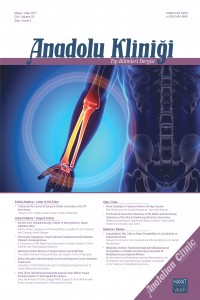Abstract
Amaç: Çalışmamızın amacı İnönü Üniversitesi Turgut Özal Tıp Merkezi Çocuk Acil Ünitesi’nde son yedi yılda karbon monoksit (CO) zehirlenmesi tanısı alan hastaların demografik, klinik ve laboratuvar özelliklerini ortaya koymaktır.
Gereç ve Yöntemler: Çalışmaya Nisan 2009 ile Nisan 2016 tarihleri arasında CO zehirlenmesi nedeniyle Çocuk Acil Ünitesi’ne başvuran 57 çocuk dahil edilmiştir. Verilerin istatiksel analizi SPSS (Ver. 17.0) paket programı ile gerçekleştirilmiştir. Karşılaştırmalarda sıklık değerlendirmesi yapılarak, en düşük ve en yüksek değerler, ortalama değerler, standart hata oranı, sayı (n) ve yüzde (%) parametreleri kullanılmıştır.
Bulgular: Çalışmaya alınan 57 hastanın yaş ortalaması 8.8±4,8 ve 36’sı kız (%63,2) idi. CO zehirlenme vakalarının yıl olarak en sık 2013 (%36,8) yılında, ay olarak ise en sık Ocak (%43,9) ayında gerçekleştiği tespit edildi. Zehirlenmelerin gün içinde en sık 19.00–07.00 saatleri arasında görüldüğü, bu dilimde de en sık (%14) 03.00–05.00 saatlerinde gerçekleştiği saptandı. Hastalarda en sık görülen başvuru şikayeti bulantı (%36,8) iken en sık görülen laboratuvar bulgusu lökositoz (%52,6) idi.
Tartışma ve Sonuç: Çalışmamız CO zehirlenmelerin en sık kış aylarında ve gece yarısından sonra olduğunu göstermiştir. En sık görülen klinik belirtiler bulantı, kusma, baş dönmesi ve baş ağrısı idi. En ufak bir ihmal tüm aileyi etkileyebilecek bir trajedi ile sonuçlanabilmektedir. Bu nedenle bacaların ve sobaların düzenli bakımı yapılmalıdır ve uyku saatlerinde sobalar tamamen sönmüş olmalıdır. Hastalar öncelikle zehirlenme ortamından uzaklaştırılmalıdır
Keywords
References
- 1. Türkiye Cumhuriyeti Sağlık Bakanlığı. Birinci basamağa yönelik zehirlenmeler tanı ve tedavi rehberleri 2007
- 2. Güven M. Karbonmonoksit Zehirlenmesi: Görünmez Kaza. Yoğun Bakım Dergisi.2005; 5(4): 221-226
- 3. Şen H. ve Özkan S. Karbonmonoksit Zehirlenmesi. TAF Preventive Medicine Bulletin. 2009; 8(4): 351-356
- 4. Metin S, Yıldız Ş, Çakmak T, Demirbaş Ş. 2010 Yılında Türkiye’de Karbonmonoksit Zehirlenmesinin Sıklığı. TAF Preventive Medicine Bulletin. 2011; 10(5): 587-592
- 5. Prockop LD. ve Chichkova RI. Carbon monoxide intoxication: an updated review. Journal of the neurological sciences. 2007; 262(1-2): 122-130
- 6. Aygin D. ve Açıl H. Çocuk acil ünitesine başvuran 0-18 yaş arası zehirlenme olgularının incelenmesi. Ş.E.E.A.H. Tıp Bülteni 2014; 48(1): 27-33
- 7. Yakar B, Ertekin YH, Ertekin H. İlaç zehirlenmesi olan çocuk olgularda demografik özellikler ve ailesel etkenlerin değerlendirilmesi. AJCI. 2016; 9(4): 189-193
Abstract
Aim: In this study, we aimed to determine demographic, clinical and laboratory characteristics of patients diagnosed with carbon monoxide intoxication at Inonu University Turgut Özal Medical Center’s Pediatric Emergency Department in the last seven years.
Materials and Methods: Fifty-seven children who had been diagnosed with carbon monoxide intoxication in the last 7 years between April 2009 and April 2016 were included in the study. The statistical analysis of the data was performed by using SPSS (Ver. 17.0) software package. The comparisons were performed assessing frequency and using minimum, maximum and mean values, standard error rates, and case number (n) and percentage (%) parameters.
Results: The mean age of the fifty-seven patients was 8.8±4.8, and of them thirty-six were female (63.2%). It was seen that CO intoxication had most frequently occurred in the year 2013 (36.8%) and in the month January (43.9%). The cases were seen to have most frequently occurred between 7.00 p.m. and 7.00 a.m., peaking between 3.00 and 5.00 a.m. (14%). The most common complaint of the patients was nausea (36.8%), and the most common laboratory finding was leukocytosis (52.6%).
Discussion and Conclusion: Our study shows that CO intoxication most frequently occurs in winter and at night after midnight. The most common symptoms are nausea, vomiting, dizziness,and headache. Slightest negligence may result in a tragedy that can involve the entire family. To avoid this, regular maintenance of chimneys and stoves is essential and the stove must be off while the household is asleep. Immediate transfer of the patient from the toxic environment to a safer place is the first rule in the management of these cases.
References
- 1. Türkiye Cumhuriyeti Sağlık Bakanlığı. Birinci basamağa yönelik zehirlenmeler tanı ve tedavi rehberleri 2007
- 2. Güven M. Karbonmonoksit Zehirlenmesi: Görünmez Kaza. Yoğun Bakım Dergisi.2005; 5(4): 221-226
- 3. Şen H. ve Özkan S. Karbonmonoksit Zehirlenmesi. TAF Preventive Medicine Bulletin. 2009; 8(4): 351-356
- 4. Metin S, Yıldız Ş, Çakmak T, Demirbaş Ş. 2010 Yılında Türkiye’de Karbonmonoksit Zehirlenmesinin Sıklığı. TAF Preventive Medicine Bulletin. 2011; 10(5): 587-592
- 5. Prockop LD. ve Chichkova RI. Carbon monoxide intoxication: an updated review. Journal of the neurological sciences. 2007; 262(1-2): 122-130
- 6. Aygin D. ve Açıl H. Çocuk acil ünitesine başvuran 0-18 yaş arası zehirlenme olgularının incelenmesi. Ş.E.E.A.H. Tıp Bülteni 2014; 48(1): 27-33
- 7. Yakar B, Ertekin YH, Ertekin H. İlaç zehirlenmesi olan çocuk olgularda demografik özellikler ve ailesel etkenlerin değerlendirilmesi. AJCI. 2016; 9(4): 189-193
Details
| Subjects | Health Care Administration |
|---|---|
| Journal Section | ORIGINAL ARTICLE |
| Authors | |
| Publication Date | May 1, 2017 |
| Acceptance Date | April 6, 2017 |
| Published in Issue | Year 2017 Volume: 22 Issue: 2 |
This Journal licensed under a CC BY-NC (Creative Commons Attribution-NonCommercial 4.0) International License.


